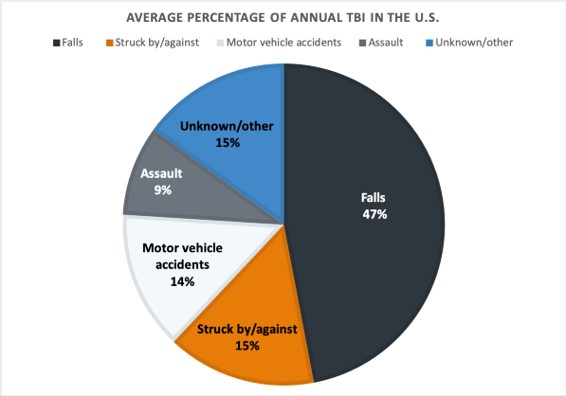Comparative negligence and other laws in California that might affect your personal injury claim
Everyone gets a bump on the head from time to time... it could be from a low-hanging tree branch, an open cabinet, or a clumsy tumble down the stairs. Most of the time, a head bump causes a bruise that takes a few days to heal and then you forget that the accident ever happened in the first place.
But there are times when a bump or other head injury is much more serious.
Certainly, each part of the human body serves a function and the last thing you want is a serious injury to any body part. But a head injury is especially dangerous because the skull is the protective house for your brain — and that controls almost every bodily function. When a bump involves more than a superficial bruise on the surface of the skull, it can become a traumatic brain injury (TBI).
A concussion is a form of TBI. However, a mild concussion will resolve itself over time.
Source: brainline, Get the States on Traumatic Brain Injury in the U.S.
California traumatic brain injury statistics
In California, there were more than 250,000 hospital visits related to TBI in 2014.
The following reflects non-fatal, unintentional California TBIs in 2014:
| Cause of injury | Number of non-fatal ER visits |
Number of non-fatal hospitalizations |
|---|---|---|
| Fall | 132,312 | 17,975 |
| Struck by object | 47,161 | 874 |
| Motor vehicle accident | 27,046 | 7553 |
| Other | 8,144 | 888 |
| Bicyclist | 6,091 | 1,023 |
| Transport, other | 3,209 | 762 |
| Cut/pierce | 596 | 19 |
| Pedestrian | 243 | 102 |
| Poisoning | 160 | 86 |
| Machinery | 136 | 39 |
| Burn | 41 | 25 |
| Firearm | 21 | 24 |
| Suffocation | 3 | 10 |
| Totals | 225,163 | 29,380 |
Source: EpiCenter California Injury Data Online, Traumatic Brain Injury
A TBI or head injury can be caused by:
- Slip and falls
- Car crashes
- Workplace injuries
- Assault (child abuse, domestic violence, shaken baby syndrome)
- Sports injuries
- Military blast injuries
- Gunshot wounds
Certainly, there are a variety of other ways you can suffer a head injury, but these are some of the most common.
California personal injury lawsuits for traumatic brain and head injuries
Although the statistics on California TBIs can help you to feel as though you’re not alone, the injury you care about most is yours, or one that affects someone you love.
If you’ve suffered a head or brain injury, or if you’re a caretaker for someone who has, the first order of business is to be sure that appropriate and thorough medical treatment is being received. You might need to make some big changes to your living arrangements, especially if you require 24-hour care or other assistance with your daily needs.
All of those things — surgeries, other medical treatment, assistive equipment and devices, caretaking — cost money. You also might be unable to work because of the injury.
Should you have to bear all of those costs if someone else’s negligence caused your injury?
The legal system says no.
California personal injury law is designed to restore a plaintiff (the injured person) to the financial status they would have if the accident had never happened. In other words, it makes the plaintiff whole.
That’s why a personal injury claim for a traumatic head or brain injury can recover damages for any costs you incur as a result of the accident.
First, the accident must be because of someone’s negligence.
Second, the injury must have a financial cost. So, if your bump on the head is just that — a bump on the head — and doesn’t require medical attention, you can’t recover damages. It might be a pain and an inconvenience, but it didn’t cost you money.
California has 5 elements necessary to prove negligence:
- The defendant had a duty to either act or not act in a specific way.
- The defendant breached their duty.
- Breach of that duty was the cause of the plaintiff’s injury.
- The defendant should have foreseen the likelihood that someone would be harmed by their action or inaction.
- The injury resulted in actual damages (cost of medical treatment, lost wages, pain and suffering, etc.).
“Duty” means that the defendant was responsible for acting (or not acting) in a certain way to avoid causing harm to the plaintiff. In a car accident case, the at-fault driver might have breached their duty to drive responsibly, adhere to speed limits, and follow the rules of the road, and those behaviors caused an accident.
If your injury was a slip and fall in a store, for example, the store employees had a responsibility to maintain the lights, floor coverings, and other parts of the property and keep the premises free from hazards (or to warn you if there is a hazard).
Recovering damages for a California brain or head injury
“Damages” is the amount of money you can recover for any personal injury.
In most personal injury lawsuits, you can recover costs for the following (compensatory damages):
- Medical treatment (which includes surgeries, hospital and doctor visits, medications, etc.)
- Assistive devices and home modifications
- Ongoing rehabilitative therapies (like speech, physical, and occupational)
- Lost wages (past and future)
- Loss of consortium
- Loss of enjoyment of the activities of everyday life
- Pain and suffering
You can sometimes recover punitive damages, which are added to your compensatory damages, when the court decides that the defendant’s behavior was so malicious, egregious, or intentional that it warrants an extra award as punishment.
California comparative fault law
There are a variety of ways states handle how fault is assigned when it comes to awarding damages. It’s not always as straightforward as plaintiff wins = plaintiff is awarded damages. In some states, including California, the court will look at not just the defendant’s liability, but also whether the plaintiff had any role in the accident.
Even if the plaintiff didn’t cause the accident, their damage award can be reduced if the court finds that they might have been able to avoid an injury had they acted differently.
This is California’s comparative fault system.
If the plaintiff is found to have any fault in the accident, the amount of damages is reduced according to the plaintiff’s percentage of fault.
Plaintiff Peter suffered a traumatic brain injury from a car accident. The court finds that Peter is entitled to $100,000 in damages.
The facts of the case show that although the defendant was clearly at fault for the collision, if the plaintiff had reacted a moment sooner by swerving or braking, the crash could’ve been avoided.
Therefore, the court finds that the defendant was 90% liable and the plaintiff was 10% liable.
Plaintiff Peter’s damages will be reduced by 10% from $100,000 to $90,000.
What to do after a California head or brain injury
Once your condition is stable, contact a qualified and experienced California brain injury lawyer to help you create a plan to keep those bills from piling up. Your lawyer will work with accountants, medical professionals, actuaries, and others to determine exactly how much you need to cover your injury-related expenses — not just now, but for the rest of your life.
Visit the resources listed below to find head trauma and TBI-related services in California:
- California Brain Injury Association
- Patient Advocate Foundation
- California Department of Rehabilitation
- Brainline resource directory
See our guide Choosing a personal injury attorney.


